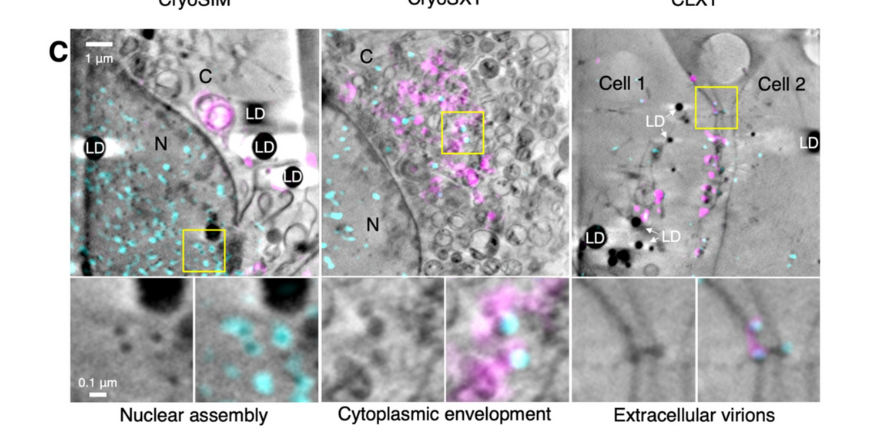
Submitted by Livia Harriman on Wed, 05/03/2025 - 12:49
In collaboration with Diamond Light Source and other institutions, researchers from the University of Cambridge have employed advanced imaging techniques to elucidate the roles of nine structural proteins in the assembly and nuclear egress of herpes simplex virus-1 (HSV-1).
This study integrates cryo-light microscopy and soft X-ray tomography, offering a novel approach to investigating viral assembly within cells.
The research team utilized fluorescent capsid (eYFP-VP26) and envelope (gM-mCherry) proteins, imaging them through structured illumination microscopy under cryogenic conditions (cryoSIM). Subsequently, they captured cellular ultrastructure from the same infected cells using cryo-soft-X-ray tomography (cryoSXT). This correlative imaging approach allowed for a comprehensive assessment of the importance of viral proteins in different stages of HSV-1 morphogenesis.
The study ranked the relative importance of five viral proteins to nuclear egress as follows: pUL34 > pUL21 > VP16 > pUL16 > pUS3. Additionally, the research uncovered the roles of five viral proteins in cytoplasmic envelopment. Notably, VP16 was found to be crucial in capsid delivery to envelopment compartments. In the absence of proteins pUL11, pUL51, gK, and gE, cytoplasmic clusters of virus particles and features of stalled envelopment, not previously described, were observed.
This innovative 3D imaging methodology enabled the visualization of different assembly stages during cytoplasmic envelopment, determining that envelopment occurs by particle budding rather than other proposed mechanisms.
The findings, published as a reviewed preprint in eLife, provide compelling data that explain previously unknown functions of these structural proteins. This work is of broad interest to virologists, cellular biologists, and structural biologists, offering a robust, contextually rich methodology for studying large protein complex assembly within the cellular environment.
Read the pre-print here: https://doi.org/10.7554/eLife.105209.1
About the University of Cambridge:
The University of Cambridge is a world-leading institution renowned for its research and teaching excellence across various disciplines. Established in 1209, it continues to contribute significantly to society through education, learning, and research at the highest international levels of excellence.
About Diamond Light Source:
Diamond Light Source is the UK's national synchrotron science facility in Oxfordshire. It enables world-class research across various scientific disciplines, providing advanced imaging and analytical capabilities to academic and industrial users.

